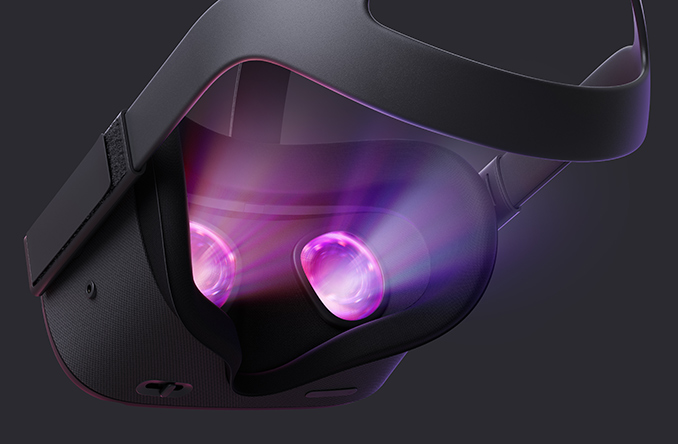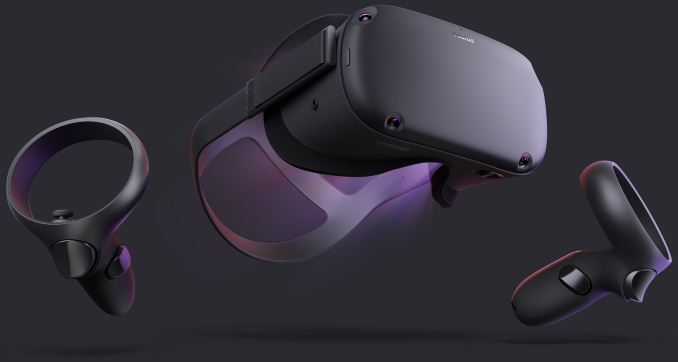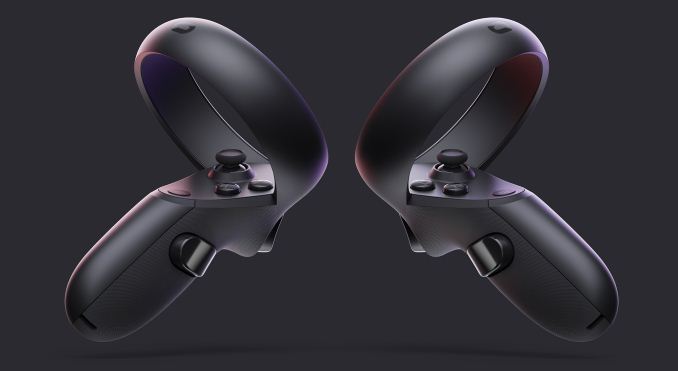Oculus Quest Announced: A 6DoF Standalone VR Headset
by Anton Shilov on September 27, 2018 5:00 PM EST- Posted in
- VR
- Oculus
- Oculus Quest

Oculus VR this week introduced its next all-in-one untethered VR headset, based around a 6-degree-of-freedom (6DoF) positional tracking system as well as the same optics as the Oculus Go launched earlier this year. Essentially an upscale, more powerful iteration of the Oculus Go, the new Oculus Quest will hit the market next spring at a price starting from $399.
The key feature of the Oculus Quest is its inside-out 6-degree-of-freedom (6DoF) positional and controller tracking that does not need any external sensors or a PC. The manufacturer says that tracking relies on four ultra-wide-angle sensors and computer vision algorithms, but does not go beyond that. When it comes to display subsystem of the Oculus Quest, the developer claims that the new unit has the same optics as the Oculus Go, but a display with a 3200×1440 (1600×1440 per eye) resolution (up from 2560×1440).
Besides graphics, Oculus VR also indicates improvements of built-in audio capabilities of the headset. Last but not least, the Oculus Quest will ship with its own Touch controllers that work just like controllers of the Oculus Rift, which will be a welcome upgrade when compared to the current-gen untethered Oculus Go headset that comes with a very simplistic controller.
Oculus VR has not disclosed which SoC it plans to use with the Quest, but considering the fact that the chip has to run games in a higher resolution than the Oculus Go and also process computer vision algorithms (unless Oculus VR uses a special purpose chip for them), it is safe to say that the new headset uses some kind of highi-end SoC (ed: it's since been confirmed that the SoC is a Snapdragon 835).
When it comes to games that take advantage of the Oculus Quest, the manufacturer promises that “over 50” titles will be available at launch, including games originally developed for Rift, such as Robo Recall, The Climb, and Moss.
The inclusion of Touch controllers as well as a more advanced SoC naturally had an effect on pricing of the new headset. The Oculus Quest 64 GB model will cost $399 (and this price alone implies on a more powerful SoC than the Qualcomm Snapdragon 821 used for the Go), which means that the unit will sit right above the Oculus Go ($199 - $249), but will still be more affordable than the Oculus Rift ($399) which requires a high-end gaming PC to function.
Related Reading:
- Oculus Go Now Available: Mainstream Standalone VR Headset Starts at $199
- HTC’s Standalone Vive Focus to Launch Worldwide This Year
- HTC Vive Pro HMD Pre-orders Start Today for $799; Vive Reduced to $499
- Lenovo Details Its Standalone Daydream VR HMD, The Mirage Solo at CES 2018
- HTC at CES 2018: Vive Pro VR Headset with Higher-Res Displays, Two Cams, Headphones
- VR Startup Varjo Announces Shipping of High Resolution Headset Prototype, Aimed at Professional Markets
Source: Oculus VR


















26 Comments
View All Comments
mode_13h - Wednesday, October 3, 2018 - link
Eh, good luck. That adds a lot of bulk (if not also weight) and its battery lasts only 2 hours. And let's hope you don't have congestion on your network.And we haven't even touched on cost - that wireless kit costs 75% as much as an entire Oculus Quest!
So, you're going to add all that cost, bulk, and weight just so a few of your users can do double-duty with this HMD for standalone + PC usage? A much better approach would be to make the Rift 2.0 wireless, and keep the Quest as a pure, inexpensive standalone unit.
Kamus - Friday, September 28, 2018 - link
>I wonder if Rift v2 will be wireless out-of-the-box, although Nvidia probably added that USB-C port to their new FE card for a good reason...By the time Rift 2 comes along, 7nm will have taken over the videocard market.
mode_13h - Wednesday, October 3, 2018 - link
Really? When is Rift v2 arriving?29a - Friday, September 28, 2018 - link
The connection between my desktop and laptop is wireless N and seems to work fine.mode_13h - Wednesday, October 3, 2018 - link
Latency requirements for VR are like 1/10th of what's tolerable for gaming.timecop1818 - Thursday, September 27, 2018 - link
latencyboeush - Thursday, September 27, 2018 - link
I think the bandwidth demands would be untenable for even the best wireless-streaming solutions. VR requires super-high framerates to avoid vertigo/nausea in the user, and uses display resolutions quite above those of a typical HDTV.Consider: you need to stream 3600x1440 at 23 bits per pixel (RGB), and at 100 FPS. This amounts to 12.442 gigabits per second of raw bandwidth. Allowing for an additional 20% margin to handle transmission protocol overhead and interference losses, you're at ~15 Gbps. There's no wireless streaming solution capable of such bit rates, as of yet.
boeush - Thursday, September 27, 2018 - link
^^ erm, I meant to write "24 bits per pixel", of course. Stupid typos + no way to edit posts = typical comment on Anandtech...Zingam - Friday, September 28, 2018 - link
Why wouldn't that be possible. You are supposed to be within a few steps away from the emitter? It is neither a WiFi connection or mobile phone.Diji1 - Friday, September 28, 2018 - link
>I think the bandwidth demands would be untenable for even the best wireless-streaming solutionsNope, the Wigig based HTC Vive Pro solution that exists now works flawlessly if we are to believe hands on reviews. It might be an issue for higher resolution headsets presumably but they don't exist yet.